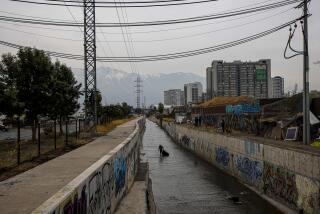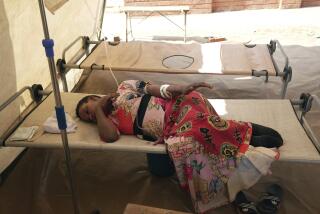Market Focus : Cholera Compounds Peru’s Economic Misery : Along with the human losses, the epidemic has taken a toll on tourism and exports--two key sectors of the struggling country.
LIMA, Peru — Poor Peru. This beleaguered South American nation already had more economic woes than Old Mother Hubbard. Then came cholera.
While adding a new measure of misery to many impoverished Peruvians’ struggle for survival, the cholera epidemic that began in late January also has dealt a withering blow to exports and tourism--two key sectors in the country’s struggle for economic recovery.
Peru’s poverty has deepened in the last two decades--hard times of counterproductive government policies, business recession, rampant inflation, guerrilla warfare and austerity measures.
And now cholera.
“Seldom or never has a country that is not involved in a foreign war gone through such penuries as Peru is suffering now, something like the seven plagues of Egypt or the Four Horsemen of Apocalypse,” lamented an editorial in the newspaper Ultima Hora.
So far, more than 150,000 Peruvians have fallen ill with cholera and more than 1,000 have died. The bacterial disease, transmitted by contaminated food and drink, causes diarrhea and rapid dehydration.
Eduardo Arrarte, president of the National Chamber of Tourism, said news of the epidemic triggered cancellations of about half of the reservations by foreigners scheduled to visit Peru, a South American tourist mecca famous for its Incan ruins, jungle excursions and other attractions.
Cholera, which preys on poor people who live in unsanitary conditions, is no threat to tourists who frequent clean restaurants and hotels, Arrarte emphasized. “The effect is psychological,” he said, predicting that tourist revenues will drop from about $350 million a year to less than $200 million in 1991.
Tourism, Peru’s No. 3 source of foreign revenues after fishing and mining, employed about 250,000 people last year, according to Arrarte. Thousands of those workers are joining the country’s unemployed and underemployed, who already account for more than half of the labor force.
Arrarte said Peru’s tourist potential of archeological treasures, Indian culture, beaches and other natural attractions are unmatched in Latin America. “We believe that the lever of development called tourism could support this whole country,” he said.
But plans for expanding the tourist infrastructure are on hold as the Chamber of Tourism prepares to invest in an overseas publicity campaign aimed at counteracting bad news of cholera.
Cusco, capital of the pre-Hispanic Incan empire and Peru’s main tourist center, has been devastated by the epidemic--despite the fact that few cases of cholera have been reported there. Thirty-eight of Cusco’s 114 hotels have closed and others are nearly empty, according to Edwin Gonzalez, president of the local hotel association.
“Tourism in the archeological capital of the Americas is in agony,” Gonzalez told a Lima newspaper.
Eduardo McBride, a vice president of the Peruvian Assn. of Exporters, said cholera has also derailed plans for increasing exports of fruits, vegetables and seafood. Those products had been expected to produce more than $100 million in export income this year. Their potential for expansion was promising before cholera broke out, but now their revenue is shrinking by millions of dollars.
Fish meal for animal feed, which earned Peru about $400 million in export revenues last year, also has lost ground--even though it is cooked at temperatures far too high for the survival of cholera bacteria.
McBride said combined losses of nearly $9 million in export revenues by early April probably were only a small sample of eventual total losses as a result of the epidemic.
Many European and Latin American countries suspended agricultural and fishery imports from Peru as the epidemic set in. After an investigation by epidemiologists, bacteriologists and other experts sent by the European Economic Community, Peru adopted sanitary measures and inspection procedures that resulted in the resumption of many shipments.
But neighboring Ecuador and Colombia, where the cholera epidemic is spreading, continued to block shipment of Peruvian agricultural and fishery products.
The United States did not ban Peruvian products but implemented strict inspection procedures at ports of entry. At first, the Food and Drug Administration required the testing of samples from 100% of all fresh and frozen Peruvian seafoods and produce. No cholera bacteria has been found, and the testing requirement is gradually being lowered to 10%.
Even though governments permit the import of Peruvian products, some importers continue to shun them, McBride said. “Prices and conditions being equal, they prefer to buy from others. We are losing markets, definitely.”
Some foreign importers are marketing Peruvian products on the sly, he said. “They said, ‘OK, send them, but the label must not say Peru.’ ”
McBride said sanitary methods and inspection procedures used by Peruvian exporters guarantee that cholera will not be spread by exports, but ungrounded fears persist in importing countries. “Ignorance and exaggeration have given us a lot of trouble,” he complained.
As the cholera epidemic moves into neighboring South American countries, economic costs are expected to grow.
“This could mean economic disaster,” said a Chilean fruit exporter after Chile’s first case of cholera was reported last week.
A Blow to Business Because of the cholera epidemic in Peru, some importers have blocked shipments of agricultural and fishery products from that country or have added strict inspection procedures at their ports. The measures have cut into Peru’s revenue from exports.
Initial export losses as of April 10 (in millions of dollars): Garlic: $1.0 Fishmeal: $2.0 Frozen hake: $1.0 Dried vegetables: $0.5 Frozen trout: $1.0 Shellfish: $2.0 Frozen asparagus: $1.0 Frozen mango slices: $0.2 Exports that are having problems getting to international markets because of the epidemic, and estimates of the epidemic, and estimates of their 1991 revenues before the cholera outbreak (in millions of dollars): Fresh fruit: $5.8 Frozen fruit: $0.1 Fresh vegetables: $2.9 Frozen vegetables: $7.5 Fruit juices: $6.5 Asparagus preserves: $17.9 Frozen fish: $11.1 Frozen shrimp: $14.0 Fish preserves: $35.8 Frozen shellfish: $5.0 Source: Peruvian Assn. of Exporters
More to Read
Sign up for Essential California
The most important California stories and recommendations in your inbox every morning.
You may occasionally receive promotional content from the Los Angeles Times.










